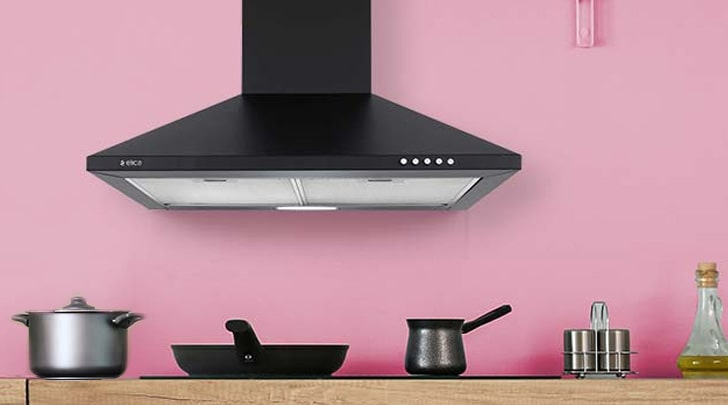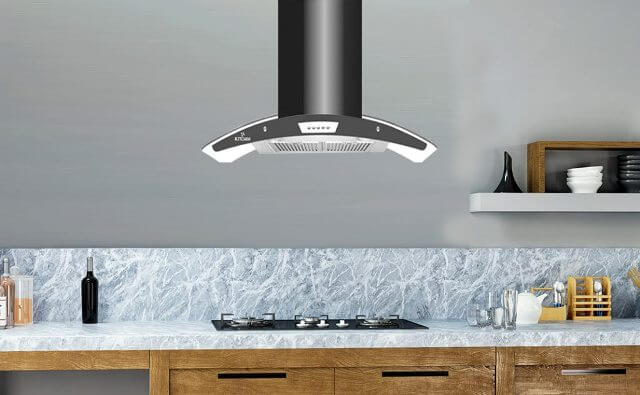
Island, built-in, corner, wall: these are just some of the types of kitchen chimneys in circulation. The kitchen chimney is an object that sucks up fumes and smells in our kitchen. It is a mandatory household appliance, in fact by law if you have a gas or electric hob you must also have a kitchen chimney.
Beyond the practical function of aspirating fumes and cooking odors, kitchen chimneys have by right become real furnishing accessories, unique and irreplaceable interior design objects. Built with precious materials (steel and glass) they also have the purpose of embellishing one of the rooms in the house where you spend more time: the kitchen. Furnishing your home with household appliances is now possible, also thanks to the latest generation kitchen chimneys.
Features and operation
The kitchen chimney must have the same or greater width than the hob, but not less. The width usually varies between 60 and 120 cm, but there are also smaller or larger models than these measures. The height, on the other hand, is variable, it depends on the length of the flue gas evacuation pipe and can oscillate between a minimum and a maximum size.
The choice of the suction power of the kitchen chimney (air flow) generally depends on the size of the kitchen and the way of cooking. The air flow is expressed in cubic meters / hour (m3 / h) and represents the quantity of air that the kitchen chimney is able to suck in at its maximum speed.
Filtering or extraction kitchen chimney
The best kitchen chimneys must be compulsorily installed when there is a gas or induction hob. It is necessary to choose the kitchen chimney model extractor, i.e., able to expel fumes and combustion residues through an appropriate flue. You may check out this guide to learn more about the things that one should consider while getting a chimney for their kitchen.
Only if it is not possible to make the evacuation duct, it is possible to use a filtering kitchen chimney, or a recirculation kitchen chimney, combined with an electric fan. These models do not expel the sucked air outside but purify it thanks to special filters and put it back into the environment. All kitchen chimneys are extractor kitchen chimneys, but they can be reconverted so that they can also perform the filtering function. Furthermore, the filter kitchen chimneys require periodic maintenance, i.e., washing or replacing the filters for odors and fats.
Types of kitchen chimneys
As regards the type of installation, there are several possible options, which vary according to personal taste and the type of kitchen in which the kitchen chimney is to be inserted.

Wall
The kitchen is positioned against the wall with the hob adjacent to the wall. Kitchen chimney can be installed on the wall. The wall model, also called a fireplace because of its shape: an elegant alternative, often in stainless steel, that can be installed on a completely free wall or between one wall unit and the other above the hob, therefore with an important visual impact.
Island
The kitchen is positioned in the center of the room with the hob away from the wall. It is a kitchen chimney to be installed on the ceiling. If you are looking for a modern and original kitchen chimney, which stands out for its aesthetics and design in a large kitchen, the trend of the moment is to prefer the type of suspended kitchen chimney or island kitchen chimney, which is anchored to the ceiling – from which hangs like a chandelier – above the cooking unit in the center of the room.
Angled
The kitchen is developed between two walls of the room and the hob is positioned close to the corner. It is a kitchen chimney to be installed between adjacent walls, with a characteristic fireplace shape. Ideal in classic furnishing contexts, but also adaptable in more modern contexts using above all steel as a material.
Built-in
The hob is positioned under a wall unit. kitchen chimney to be installed inside the wall unit. This model is also called an undercabinet kitchen chimney, concealed hidden by a kitchen cabinet door, and the fully visible or semi-integrated models. Much loved, the under-cabinet kitchen chimney guarantees excellent suction results and wins in terms of practicality, also from the point of view of cleaning, especially in small kitchens where there are few wall units available.
Installation and maintenance
The perfect functioning of the kitchen chimney is ensured by correct installation, guaranteed by specialized personnel. It is advisable to verify that the company offers this service. Assembly and maintenance vary according to the two types of kitchen chimneys: suction and filtering.
Maintenance depends on the type of filters used in the kitchen chimney, which may be carbon and metal. The charcoal filters will need to be replaced once every three months to ensure that the appliance works properly. While for metal filters they are cleaned manually with specific detergents every 60 days.
If bad smells remain after cooking, or if the stove flame seems to be sucked by the fan, it means that something is wrong; perhaps the filters, having reached saturation, need to be replaced, or it is necessary to double check the correct position of the kitchen chimney and the use we make of it. In fact, this appliance must be turned on while cooking and turned off 5-10 minutes after having finished fumbling in the stove.